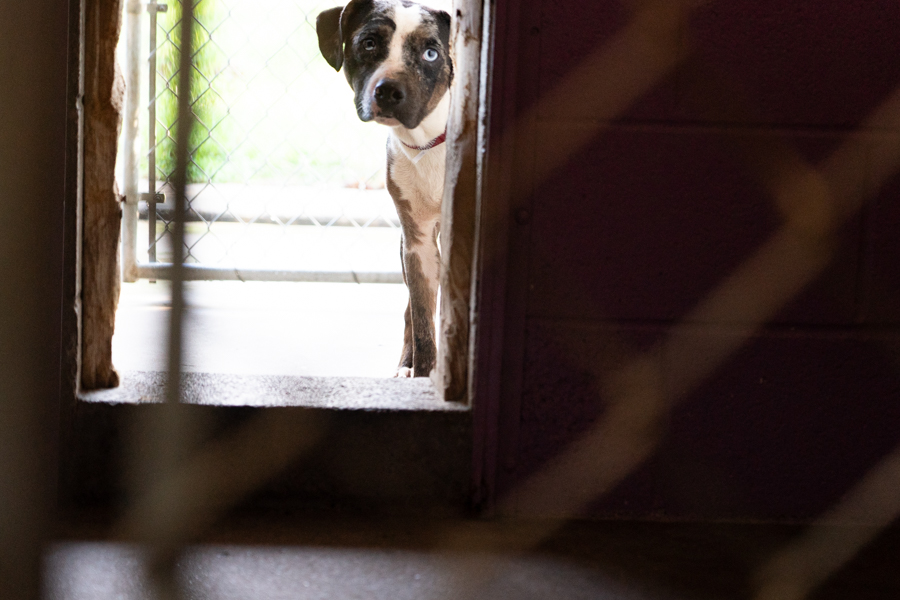Mercer County Animal Control Center Kentucky was full when we visited (like every other shelter we’ve visited in the last year), but only a handful of those dogs are adoptable. That’s because the shelter took in thirty dogs seized in a hoarding situation at the president of the local Humane Society’s home seven weeks before our visit in October of 2024.
Too often, municipal shelters are required to hold dogs involved in court cases indefinitely, clogging their kennels and leading to other dogs in need of care being turned away or euthanized.
Twenty of the dogs seized are at the shelter, and another seven are in foster care because they have critical health issues or are too elderly to handle shelter life, one had to be euthanized, and two remain at the veterinary hospital (on the county’s dime).
[UPDATE: the case could go to trial March 14. The county still has been able to place most of the dogs through rescues, but had to euthanize some because of condition/temperament/age, and four remain at the shelter.]

Shelter director, Wendy, does not believe the county should hold the dogs indefinitely. During the months that they have been required to hold these dogs, they have been unable to help other dogs. It has also tied up resources—it costs $51/month for each dog the county feeds and cares for). That’s on top of the initial investment in vaccines and veterinary assessment of all the dogs, plus any necessary treatment, and several that had to be boarded at the vet’s office because they required round the clock care. Most of the dogs arrived at the shelter flea-infested with sores and hair loss.
The county shelter has spent a lot of money to hold and treat the dogs, and while this case is winding down, there will surely be others. Kentucky is considering a Cost-of-Care law that would require that shelters be compensated for holding dogs for situations like this. Every state should have some kind of Cost-of-Care regulations in place.
The HS dogs have been particularly challenging because they had not been socialized well and were not easy to place. With little volunteer help, it has been hard for Wendy to give the dogs the attention they need. Even getting them outside to run is hard because Wendy can only utilize the vast outdoor area for the dogs one at a time. So, the dogs spend pretty much every day in their kennels. Finding a way (and the funds) to divide up the space would have helped this situation and would be very helpful for all the dogs.



The shelter has 27 kennels. The court case dogs were using 20 of them when we visited, and had five other dogs in shelter care. Which means the shelter was full, with only two available kennels for animal control calls and lost dogs.
Wendy counsels residents who want to surrender their dogs to rehome their dogs themselves. She provides them with a list of resources to help them do that and will advise them on how to screen potential new owners. She explains how much better it is for their dog if they go from their home to the new home without spending time in a shelter (we would echo that). The shelter also has a pantry of free dog food/treats/supplies in the lobby of the shelter.


There are currently three staff at the shelter (they are looking for an additional part-time kennel attendant). Wendy, plus one full-time and one part-time ACO. There have a few excellent volunteers, but Wendy would love to have more volunteers to walk dogs. The challenge is that shelter hours are 10-4, and the shelter sits on the county campus, whose gates are locked up at 4:30 every day. Finding volunteers available between those hours is hard.
The shelter normally takes in 200-300 animals a month. It is lucky to have the help of a relatively new local rescue called PuppyLove KY, which fosters animals for the shelter.
Wendy has worked at the shelter for eight and half years. She came to the shelter after 18 years in customer service, sales and marketing, plus a lifetime of training horses. She is a strong leader, and that’s clear with the dogs, who all greet her happily and quiet down at her request. It was remarkable that so many dogs in one space who rarely get out to play would be so quiet we could have a conversation inside the kennel area.



You won’t see a lot of the pictures of the dogs we met because, as I mentioned, they are being held for the court case. This means we can’t post their pictures, and Wendy can’t post them for adoption/rescue.
Beyond the court case dogs, the shelter had two medium-sized dogs, an Aussie on stray hold and a gorgeous German Shepherd, plus one pit bull who was recovering from spay surgery in a foster home.




When I asked Wendy what she needed, she said, “Adopters and volunteers.”
The county plans on building a new shelter on the same property, but funds have been redirected toward the hoarding case dogs’ vet bills. The current building is fifty years old with unreliable plumbing and electrical.
It’s sad, but not as uncommon as you’d expect, that the shelter was inundated by dogs seized at the home of the president of the Humane Society which was created to (and originally did) help the shelter. Nonprofit rescues are rarely regulated or inspected by already overloaded government agencies. They largely rise and fall based on the personalities that run them.
And one thing I can tell you after wading so deeply into shelter and rescue is that they are populated with powerful personalities who are passionate about animals. Which is good and bad, as is clear in Mercer County.
Wendy is knowledgeable, experienced, and understands animals. The dogs trust her; she’s their pack leader. Hopefully, this county will trust her to find a better outcome for these dogs than living indefinitely in small kennels while the humans who failed them are brought to justice.

If you’d like to support the work Wendy does, consider shopping the shelter’s Amazon wishlist.
I don’t know what the answer is for dealing with dogs seized by law enforcement that end up in our municipal shelters. Legally, what else is there to do? But too often, these innocent animals are held for months or years awaiting their outcome, and in the meantime, they live in a stressful situation and cost taxpayers a lot of money. It’s a discussion that needs to happen –isn’t there a better way to do right by the animals caught in the middle?
We are leaving soon for a 12 shelter tour in VA, TN, NC, and GA to visit 13 shelters and rescues. Follow along as we share live videos, pictures, and updates on Facebook and Instagram.

Cara
If you want to learn more, be sure to subscribe to our email list to get the latest stories and solutions delivered to your inbox. And help us spread the word by sharing this post with others. Visit our website to learn more.
You can also help raise awareness by following/commenting/sharing our content on Facebook, Instagram, YouTube, and Tik Tok.

Who Will Let the Dogs Out: Stories and Solutions for Shelters and Rescues was published in January of 2025. It is filled with stories and ideas to help everyone be part of the solution. You can buy a hardback or paperback copy for yourself and/or buy a copy for a shelter or rescue through our website. It is also available on Amazon in paperback and ebook. We are looking for opportunities to share a presentation of the ideas in the book and facilitate conversations about how we can work together to find solutions for our shelters. If you have a dog-hearted group that would like to connect, contact Cara@wwldo.org.
To see our Emmy-nominated, award-winning short documentary, Amber’s Halfway Home, click here.
For more information on any of our projects, to talk about rescue in your neck of the woods, or partner with us, please email cara@WWLDO.org.



Leave a Comment
Sign up for our newsletter
Sign up to have our latest news, grant updates, shelter visits, and more delivered to your inbox.
Share this:
Like this: